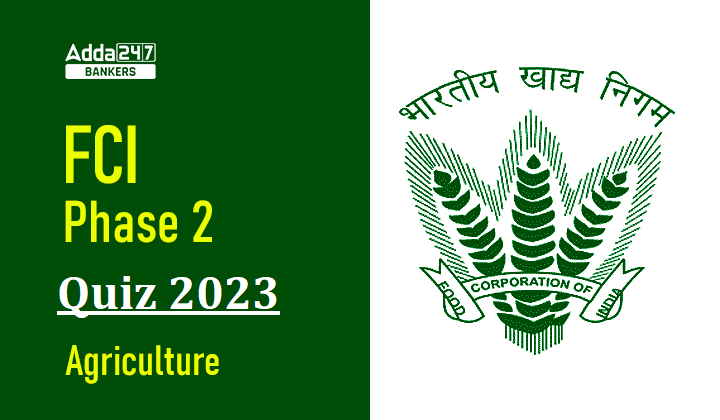Q1. The botanical name of Lima beans is _________________?
(a) Phaseolus vulgaris
(b) Phaseolus lunatus
(c) Phaseolus radiatus
(d) Phaseolus mungo
Q2. The food grain production target set by the GOI for the year 2022-23 is _______________ mt.
(a) 328
(b) 350
(c) 312
(d) 410
Q3. The botanical name of little millet is ___________?
(a) Setaria italica
(b) Paspalum scrobiculatum
(c) Panicum sumatense
(d) Panicum millaceum
Q4. The scheme named Intercropping of pulses with sugarcane is implemented in how many states?
(a) 13
(b) 14
(c) 10
(d) 12
Q5. How many seed hubs have been created in ICAR institutes, SAUs and KVKs in order to increase certified pulse seed production?
(a) 130
(b) 150
(c) 142
(d) 175
Q6. World Pulse Day is celebrated on __________?
(a) 11th February
(b) 12th March
(c) 10th February
(d) 15th March
Q7. The other name of the 1st rice hybrid variety of India, MGR-1 is-
(a) CoRH-1
(b) CoRH-2
(c) CoRH-10
(d) Jaya
Q8. Indian Grain Storage Institute is located at __________?
(a) Uttar Pradesh
(b) Haryana
(c) Tamil Nadu
(d) Uttarakhand
Q9. Indian Institute of Pulse Research is located at ______?
(a) Lucknow
(b) Gurgaon
(c) Kanpur
(d) Prayagraj
Q10. Which crop is also known as King of coarse grains?
(a) Jowar
(b) Bajra
(c) Maize
(d) Wheat
Solutions
S1. Ans (b)
Sol. A lima bean (Phaseolus lunatus), also commonly known as the butter bean, sieva bean, double bean, Madagascar bean, or wax bean is a legume grown for its edible seeds or beans.
S2. Ans (a)
Sol. The government set a food grain production target of 328 million tonne (mt) for the 2022-23 crop year (July-June) which is 4% more than a record foodgrain output of 315.7 mt in the previous year.
S3. Ans (c)
Sol. Panicum sumatrense, known as little millet, is a species of millet in the family Poaceae. It is an annual herbaceous plant, which grows straight or with folded blades to a height of 30 centimetres (12 in) to 1 metre (39 in). The leaves are linear, with the sometimes-hairy laminae and membranous hairy ligules. The panicles are from 4 to 15 cm (1.6 to 5.9 in) in length with 2 to 3.5 mm (0.079 to 0.138 in) long awn. The grain is round and smooth, 1.8 to 1.9 mm (0.071 to 0.075 in) long.
S4. Ans (d)
Sol. “Intercropping of pulses with sugarcane” was implemented in 12 States namely- Bihar, Gujarat, Haryana, Karnataka, Madhya Pradesh, Maharashtra, Odisha, Punjab, Tamil Nadu,Telangana, Uttar Pradesh and Uttarakhand during 2018-19 and 2019-20.
S5. Ans (b)
Sol. A total of 150 seed hubs have been created at ICAR institutes, SAUs and KVKs to ensure availability of seeds of pulses and human resource development; and increase in additional breeder seed production of pulses through twelve centres of ICAR and SAUs.
S6. Ans (c)
Sol. In order to further achieve the 2030 Agenda for Sustainable Development, the United Nations General Assembly (UNGA) designated 10 February as World Pulses Day (WPD).
S7. Ans (a)
Sol. MGR-1 (earlier named as CoRH-1) developed first by Tamil Nadu.
S8. Ans (a)
Sol. Indian Grain Storage Management and Research Institute (IGMRI) formally, Grain Storage Research and Training Centre which was established at Hapur in 1958 and later renamed as Indian Grain Storage Institute in order to provide a holistic expanse to the training curriculum and the activities of the Institute, with two field stations at Ludhiana and Hyderabad with financial assistance from the UNDP during 1968-73. The Indian Grain Storage Management and Research Institute (IGMRI), Hapur and its two field stations located at Hyderabad and Ludhiana conduct applied Research & Development activities on various aspects of post-harvest management of food grains.
S9. Ans (c)
Sol. Indian Institute of Pulses Research (IIPR) is a government institute in Kanpur, Uttar Pradesh. It was established in the year 1983 by the Indian Council of Agricultural Research (ICAR) to carry out basic strategic and applied research on major pulse crops.
S10. Ans (a)
Sol. Sorghum is known as the king of coarse grains. The other name for sorghum is drought crop since it is resistant to drought. It has earned this name because of its ability to grow in arid soils and withstand prolonged droughts.



 GA Capsule for SBI Clerk Mains 2025, Dow...
GA Capsule for SBI Clerk Mains 2025, Dow...
 The Hindu Review October 2022: Download ...
The Hindu Review October 2022: Download ...
 IBPS RRB Clerk Syllabus 2025 and Exam Pa...
IBPS RRB Clerk Syllabus 2025 and Exam Pa...




